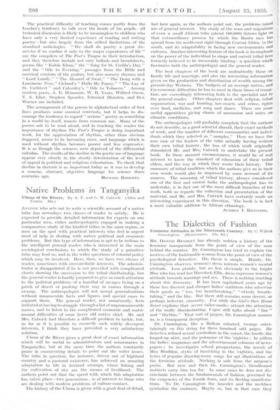Native Problems in Tanganyika
ANYONE who sets out to write a scientific account of a native tribe has nowadays two classes of reader to satisfy. He is expected to provide detailed information for experts on one particular area, either anthropologists engaged in making a comparative study of the kindred tribes in the same region, or men on the spot with practical interests who feel in urgent 'seed of help in dealing with native political and economic. problems. But this type of information is apt to be tedious to the intelligent general reader, who is interested in the main Sociological conclusions to which the study of a primitive tribe may lead us, and in the wider questions of colonial policy which may be involved. Here, then, we have two classes of reader, sometimes with irreconcilable interests. The adminis- trator is disappointed if he is not provided with complicated charts showing the succession to the tribal chieftainship, but the general reader is hardly prepared to give so much attention to the political problems of a handful of savages living on a patch of desert or pushing their way in canoes through a swamp. The anthropologist will not accept generalizations without innumerable facts and figures and special eases to support them. The general reader, not unnaturally, feels irritated at having to struggle through a list of unpronounceable names, and to listen to the complicated economic and matri- monial difficulties of some Seery old native chief. Mr. and Mrs. Culwick had therefore a difficult problem to tackle, but, as far as it is possible to reconcile such widely divergent interests, I think they have provided a very satisfactory solution.
Ubena of the Rivers gives a great deal of exact information Which will be useful to administrators and missionaries in Tanganyika, but at the same time the authors constantly pause in enumerating details to point out the wider issues. The tribe in question, for instance, driven out of highland country and a pastoral existence, has achieved an amazing adaptation to life in lowland swamps, where fishing and the cultivation of rice are the means of livelihood. The authors point out that the speed with which this adaptation has taken place—two generations—is of interest to those who are dealing with modern problems of culture-contact.
The history of the Ubena is given with a good deal of detail, but here again, as the authors point out, the problems raised are of general interest. The study of the wars and migrations of even a small African tribe (about 160,000) throws light 00 that extraordinary process by which the Bantu race has spread from the north-east right through Central Africa to the south, and its adaptability in facing new environments and cultures. Another interesting feature of the book is its emphasis on the power of the individual to shape and outwit tribal laws formerly believed to be inexorably binding—a question which fascinates both the anthropologist and the general reader.
The best chapters of the book are undoubtedly those on family life and marriage, and also the interesting information given on the production and distribution of wealth among the present-day Wabena. The budgets of an average native, and the economic difficulties he has to meet in these times of transi- tion, are exceedingly interesting both to the specialist and to the general reader. Other chapters deal with religion, tribal organisation, war and limiting, law-courts and crime, rights over land, medicine, and song and dance. There are some useful appendices giving charts of succession and notes on climatic conditions.
The anthropologist will probably complain that the authors do not describe, as a good scientist should, their exact methods of work, and the number of different communities and indivi- duals which they selected as " samples." Here we have the rare case of the leaders of the tribe actually having written their own tribal history, the loss of which work originally stimulated Mr. and Mrs. Culwick to undertake the present book. In these unusual circumstances, it would be of real interest to know the standard of education of these tribal elders, and the way in which they wrote their history. The summary of tribal tradition which the authors give us in their own words would also be improved by some account of its sources. The amassing of tribal history, always considered one of the first and easiest tasks the anthropologist has to undertake, is in fact one of the most difficult branches of his Work, both as regards the collection and presentation of the material, and Mr. and Mrs. Culwick have certainly made an interesting experiment in this direction. The book is in fact a most valuable addition to African ethnology.
AUDREY I. RICHARDS.


































 Previous page
Previous page